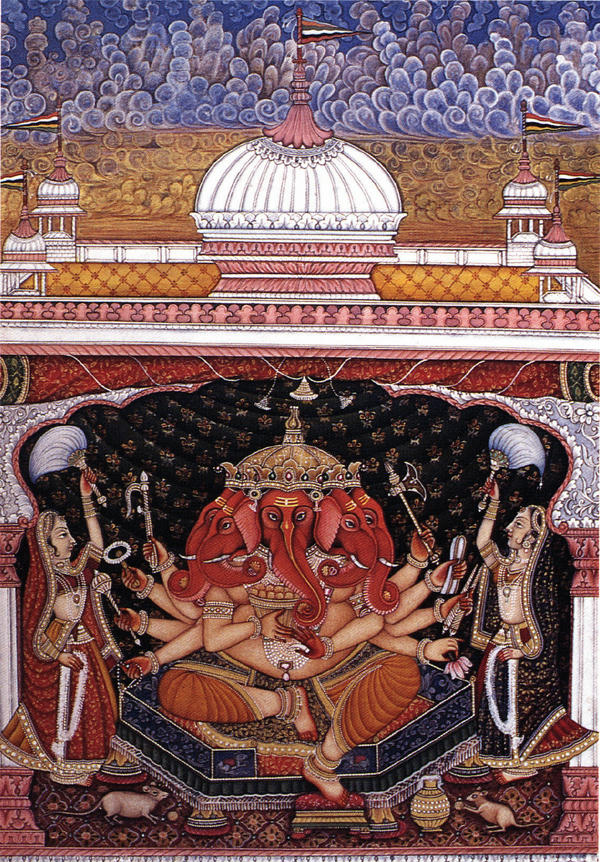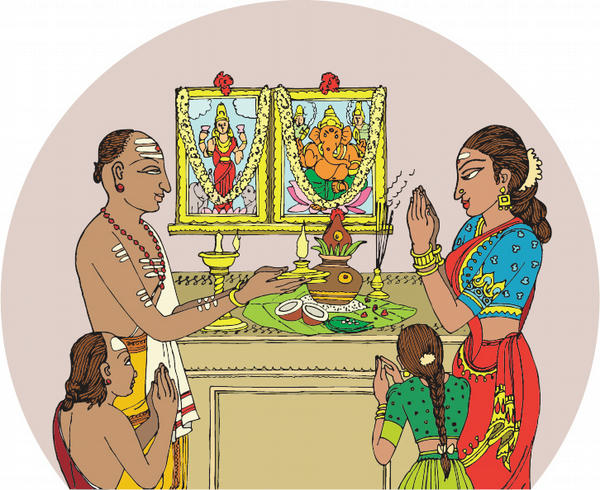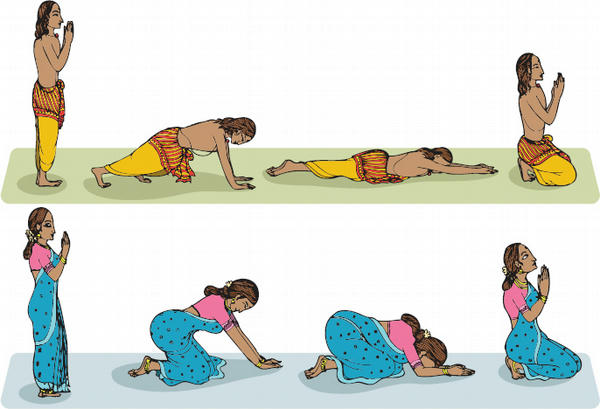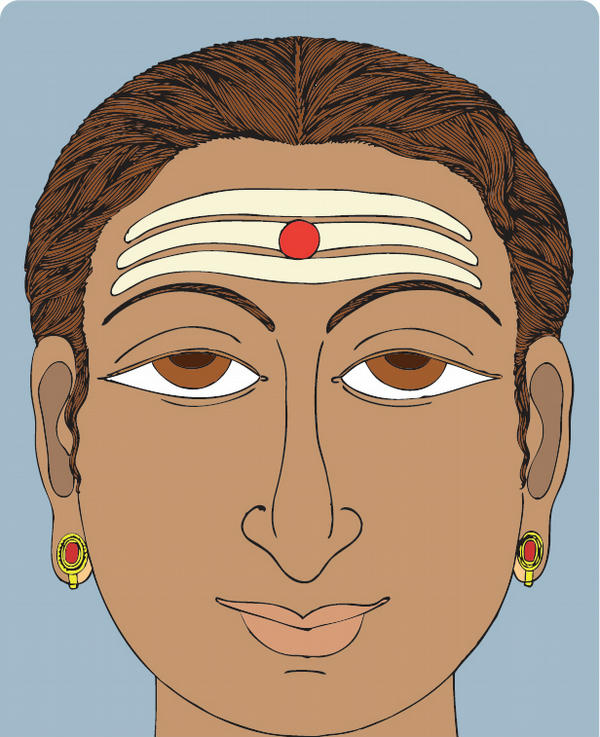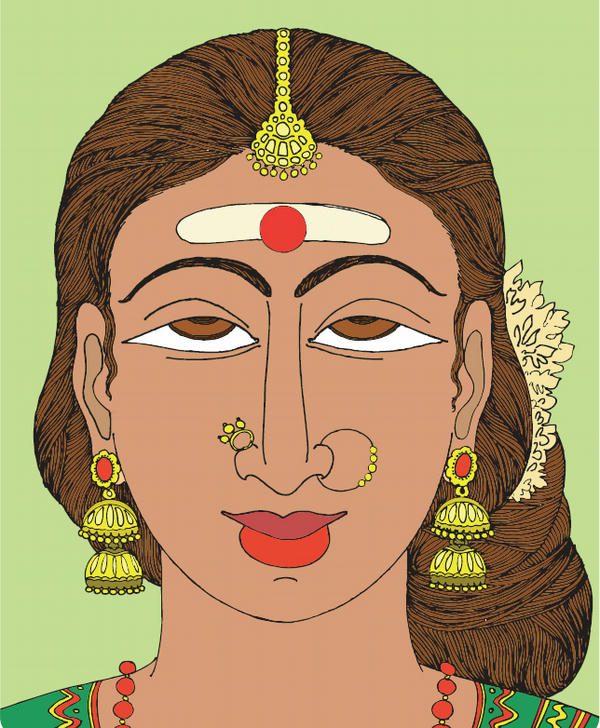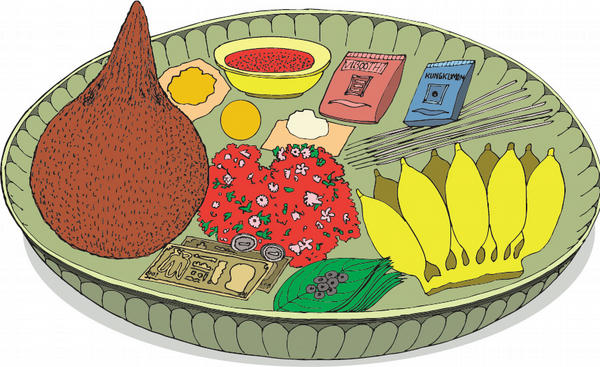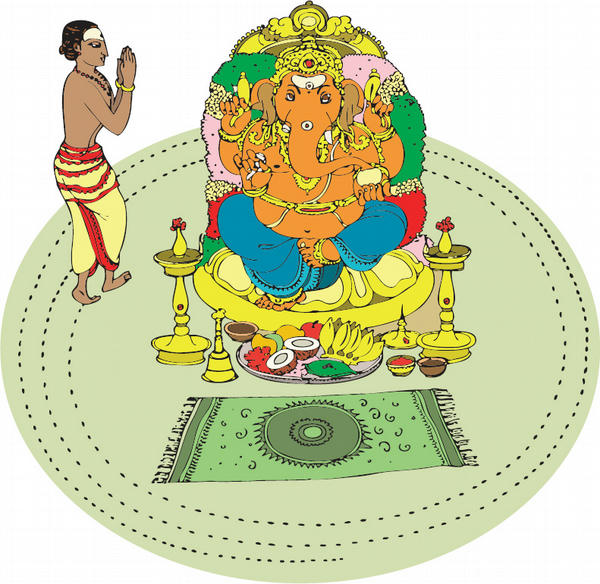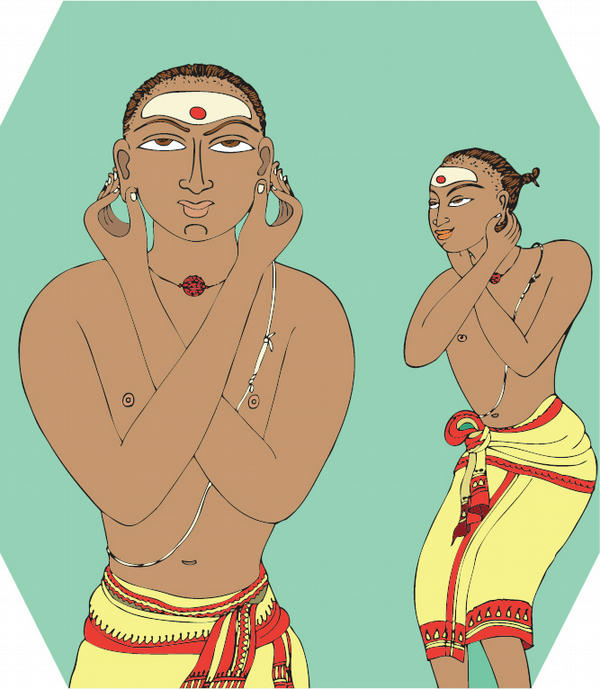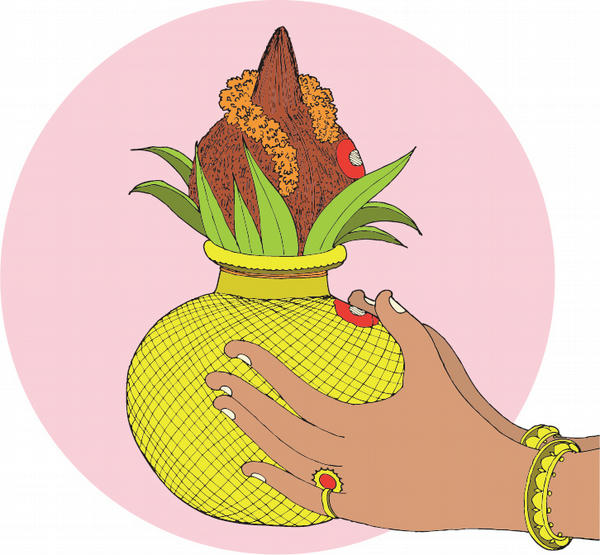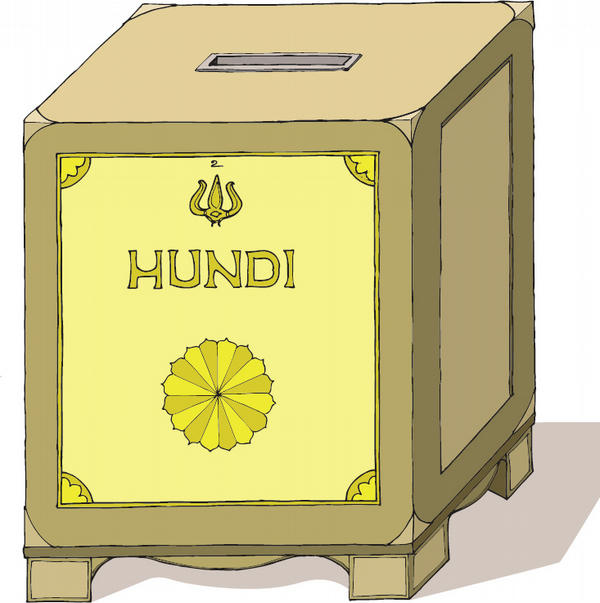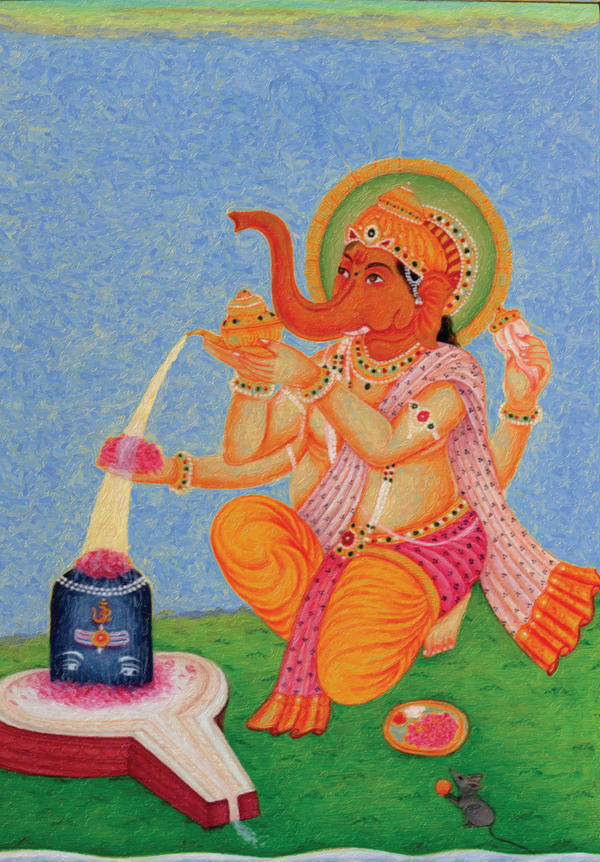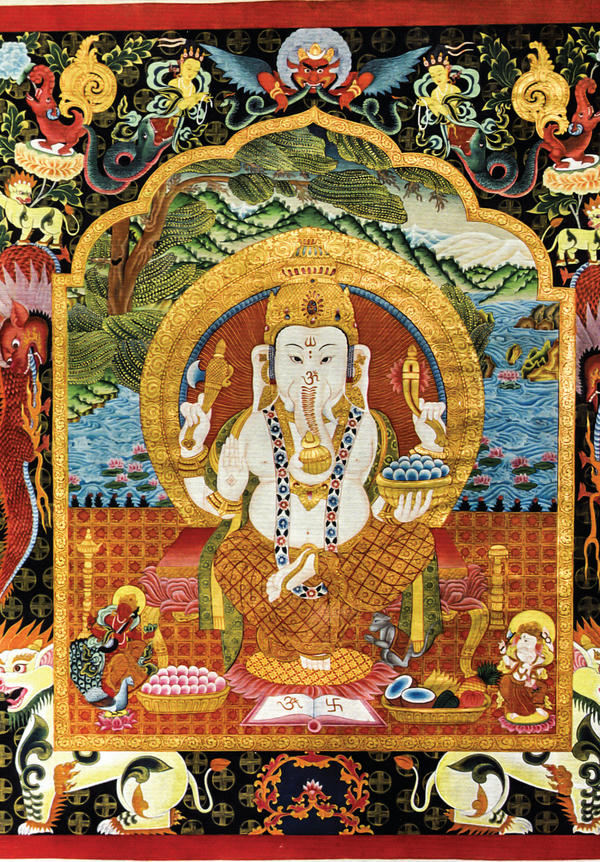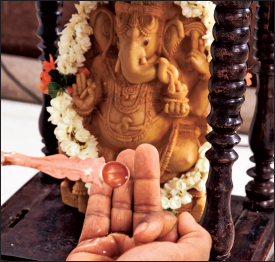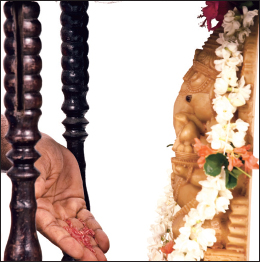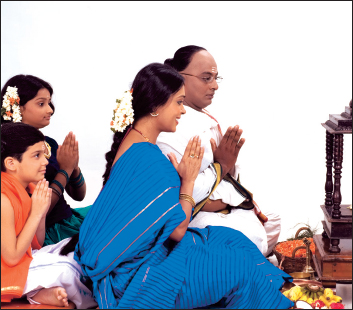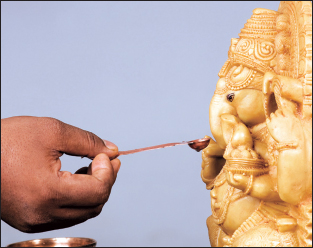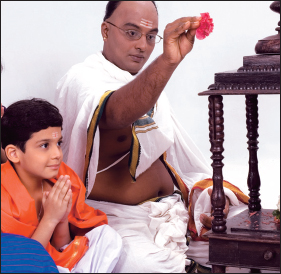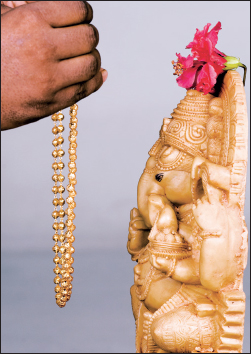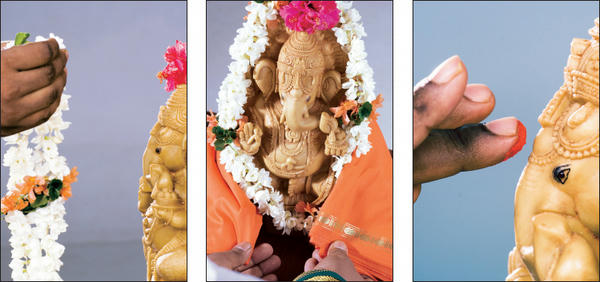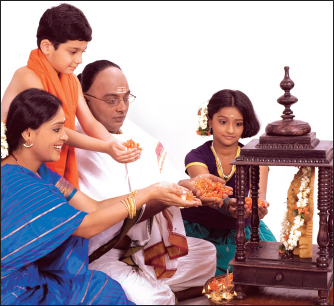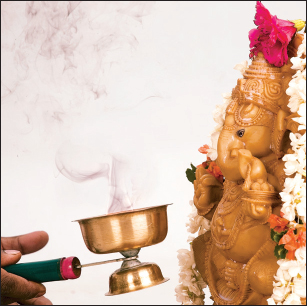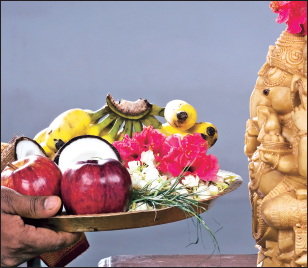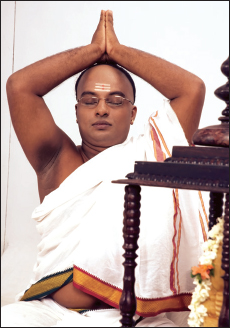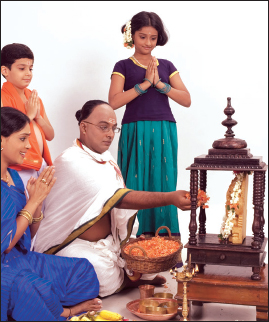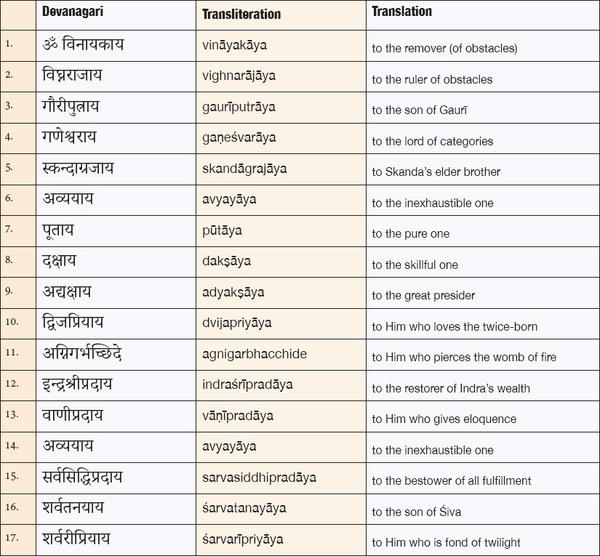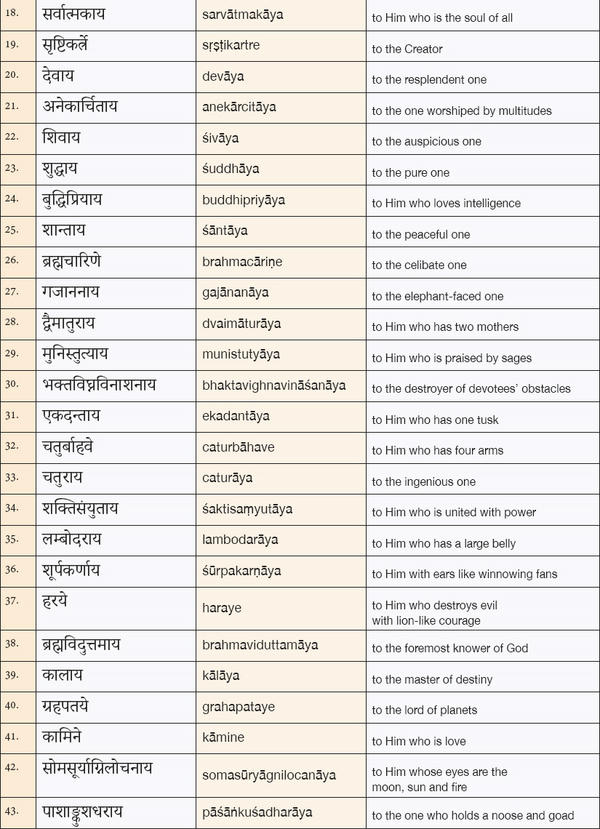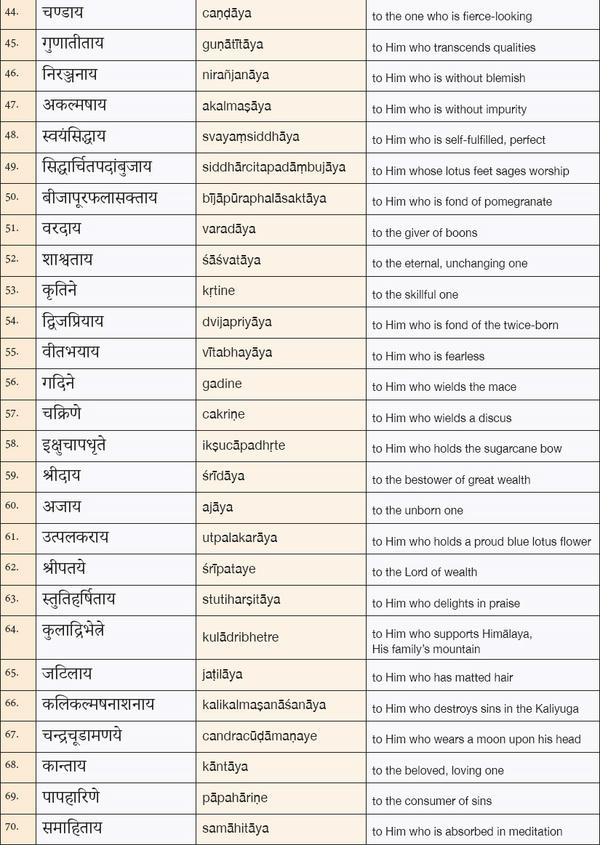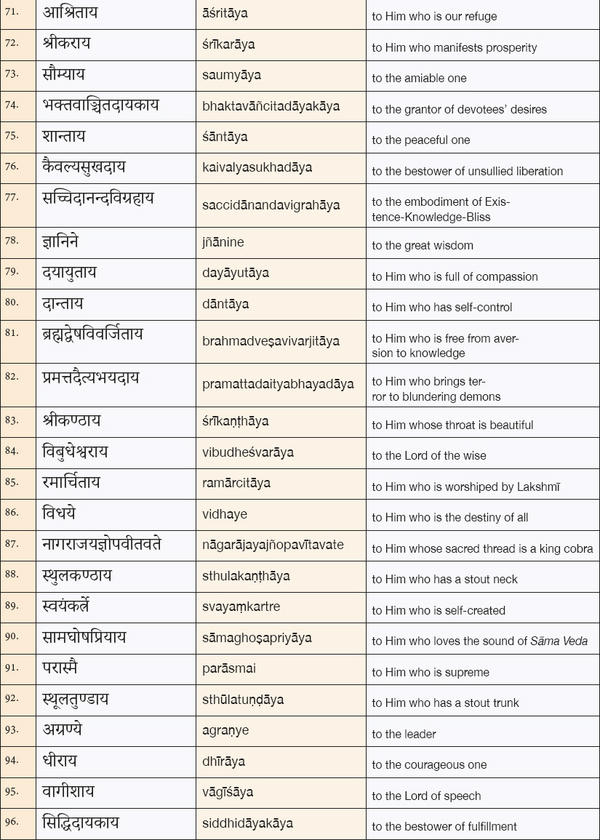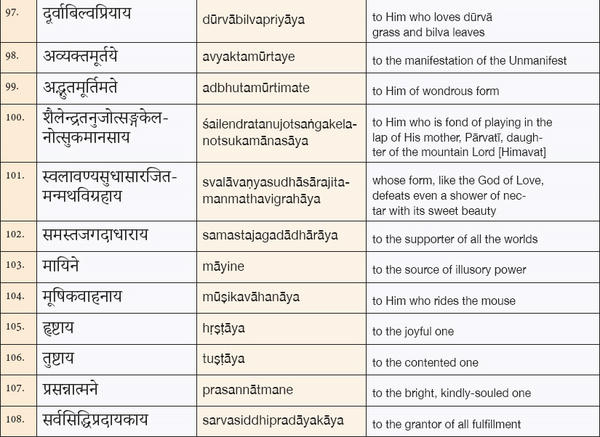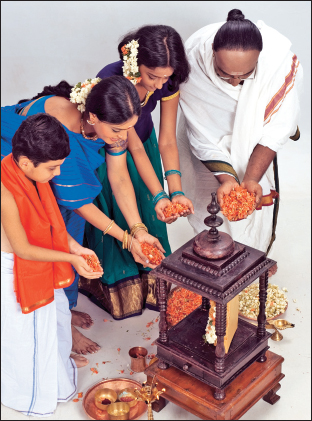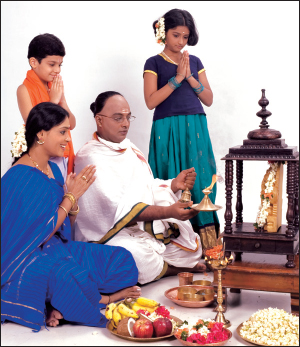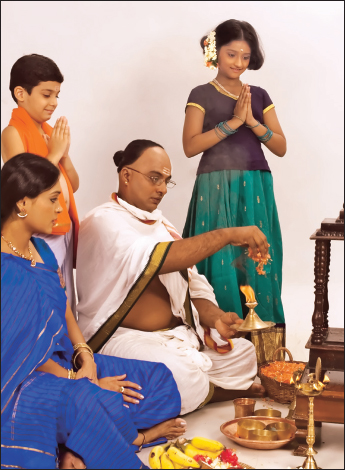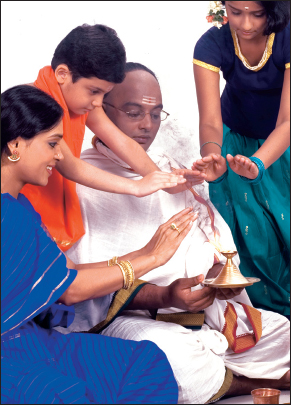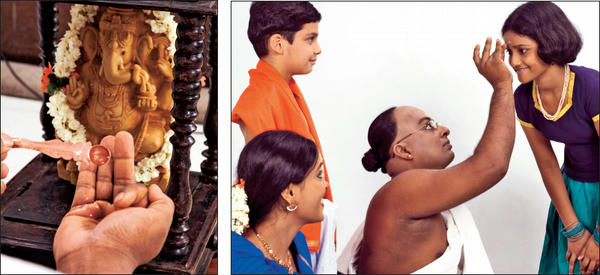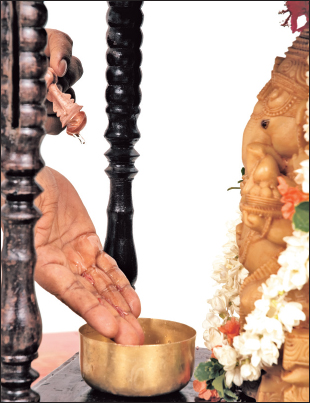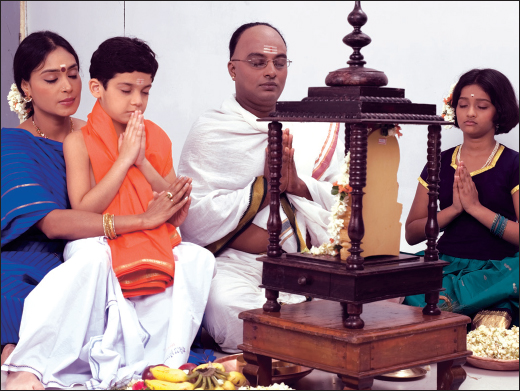Gaṇeśa Worship§
Gaṇeśopāsanā§
गणेशोपासना§
 OVE AND JOY COME TO HINDU FAMILIES WHO WORSHIP LORD GAṆEŚA IN their home through the traditional ceremony known as pūjā. By means of such sacred rites and the divine energies invoked, each family makes their house a sacred sanctuary, a refuge from the concerns and worries of the world. Pūjās can be as simple as lighting a lamp and offering a flower at the Lord’s holy feet; or they can be elaborate and detailed, with many chants and offerings. The indispensable part of any pūjā is devotion. Without love in the heart, outer performance is of little value. But with true devotion, even simple gestures are sacred ritual. In this chapter we present a simple pūjā that anyone desirous of invoking our loving Gaṇeśa can perform. Sanskrit and English are given here, but the latter can easily be translated into your own native language. All family members should understand the meaning of the rites. Sanskrit should not become a barrier to performing Gaṇeśa pūjā. After all, He understands all dialects. One need not be initiated to perform this pūjā invoking our loving Gaṇeśa. All that is required is that the celebrant believe in the laws of karma and reincarnation, which are the cornerstones of Hindu ethical and philosophical doctrine. Gaṇeśa worship is enjoyed by all, Hindus and non-Hindus alike, as He is the first God to be worshiped. It is not wise for an ardha-Hindu, or half Hindu, to centralize worship on Śiva or Murugan or other Gods until full commitment has been made through receiving the traditional sacraments, called saṁskāras. Home pūjā is performed at least once a day, usually in the early morning. It is traditional to not partake of food at least three hours before pūjā, so pūjā is usually done prior to meals.§
OVE AND JOY COME TO HINDU FAMILIES WHO WORSHIP LORD GAṆEŚA IN their home through the traditional ceremony known as pūjā. By means of such sacred rites and the divine energies invoked, each family makes their house a sacred sanctuary, a refuge from the concerns and worries of the world. Pūjās can be as simple as lighting a lamp and offering a flower at the Lord’s holy feet; or they can be elaborate and detailed, with many chants and offerings. The indispensable part of any pūjā is devotion. Without love in the heart, outer performance is of little value. But with true devotion, even simple gestures are sacred ritual. In this chapter we present a simple pūjā that anyone desirous of invoking our loving Gaṇeśa can perform. Sanskrit and English are given here, but the latter can easily be translated into your own native language. All family members should understand the meaning of the rites. Sanskrit should not become a barrier to performing Gaṇeśa pūjā. After all, He understands all dialects. One need not be initiated to perform this pūjā invoking our loving Gaṇeśa. All that is required is that the celebrant believe in the laws of karma and reincarnation, which are the cornerstones of Hindu ethical and philosophical doctrine. Gaṇeśa worship is enjoyed by all, Hindus and non-Hindus alike, as He is the first God to be worshiped. It is not wise for an ardha-Hindu, or half Hindu, to centralize worship on Śiva or Murugan or other Gods until full commitment has been made through receiving the traditional sacraments, called saṁskāras. Home pūjā is performed at least once a day, usually in the early morning. It is traditional to not partake of food at least three hours before pūjā, so pūjā is usually done prior to meals.§
The Sanctity of the Home Shrine§
All Hindus attend pūjā at their local temple at least once a week and maintain a sacred shrine at home, which esoterically functions as an extension of the temple. The shrine room is meticulously cared for and not used for purposes other than worship, prayer, scriptural study and meditation. Here, pūjā, home liturgy, is performed daily, generally by the head of the house. All members of the family attend.§
Establishing a Home Shrine§
Creating a home shrine is not difficult. The altar should be close to the floor, since most of the pūjā is performed while seated, though when there are small children in the home it is often higher, out of their reach. For a Gaṇeśa shrine, an image or mūrti of Lord Gaṇeśa is placed at the center of the altar. A metal or stone image is best, but if not available there are two traditional alternatives: 1) framed picture, preferably with a sheet of copper on the back, or 2) a kumbha, which is a symbol of Gaṇeśa made by placing a coconut on a brass pot of water with five mango leaves inserted between the coconut and the pot. The coconut should be husked but still have the fibers on the top. (See illustration on p. 234.) Bathing the God’s image, or mūrti, is part of the pūjā. For this, special arrangements may need to be made. Most simply, the mūrti may be placed in a deep tray to catch the water. After the bath, the tray is removed and the mūrti dried off, then dressed and decorated. More elaborately, a drain may be set up so the water flows into a pot at the side of the altar. This blessed water is later served by the pujārī, who places a small spoonful in each devotee’s right palm.§
Pūjā Items§
Pūjā implements for the shrine are kept on a large metal tray. On it are arranged ghee lamps, bells, cups, spoons and small pots to hold the various sacraments. Available from Indian shops, these are dedicated articles, never used for purposes other than pūjā. The necessary items are:§
1. two water cups and a small spoon for offering water;§
2. a small brass cup of unbroken, uncooked rice mixed with enough turmeric powder to turn the rice yellow;§
3. a tray or basket of freshly picked flowers (without stems);§
4. a standing oil lamp, dīpastambha, which remains lit throughout the pūjā (and ideally kept lit through the day).§
5. a dīpa (lamp with cotton string wick) for waving light before the Deity;§
6. a small metal bell, ghaṇṭā;§
7. an incense holder and a supply of incense sticks, agarbhatti;§
8. a container of holy ash, vibhūti;§
9. a small cup of sandalwood paste, chandana;§
10. a small container of red powder, kuṅkuma;§
11. naivedya, fresh fruit and/or a covered dish of freshly cooked food (most often rice) to offer the Deity;§
12. a camphor (karpura) burner for passing the sacred flame before the God at the height of the pūjā.§
13. Additional items often include small Indian pots for bathing the mūrti, colorful clothing for dressing the mūrti, garlands and additional oil lamps to light and decorate the room, and an audio player.§
Restrictions from Entering a Shrine§
Before entering the shrine room, all attending the ceremony bathe, dress in clean clothes and bring a small offering of flowers or fruit (prepared before bathing). It is traditional for women during their monthly period to refrain from attending pūjā, entering the shrine or temple or approaching swāmīs or other holy men. Also during this time women do not help in pūjā preparation, such as picking flowers or making prasāda for the Deity. At this time of retreat, ladies are allowed to rest and perform private sādhanas, such as haṭha yoga, japa, prāṇāyāma, meditation and reading the holy texts.§
This same rule applies to men or women with injuries that are in the process of healing; minor scratches are excepted. Cuts and injuries that bleed, internal bleeding and operations create psychic openings in the prāṇic aura that render the worshiper vulnerable to intrusion from lower astral Naraka denizens, who may enter or draw out energy and do damage with that energy. The period of retreat extends until the bleeding stops and there is no more danger of infection. A minor cut or scratch may reach this point within a few hours. A deeper cut will generally take two or three days to knit to the point that no restriction is required. A severe wound may take ten days or longer. A major operation, such as heart surgery, caesarean section or appendicitis, might require several weeks or even longer before the person feels whole again. This means that you do not go to a Hindu temple to get healed from injuries such as these, though loved ones can go to pray on your behalf.§
When I was in Jaffna in 1948 and 1949, living as a guest in the homes of strict Śaivite Hindus, I was impressed that they had a small house made of thatched cajan at the far end of the family compound where the women of the household went for three or four days or more each month until their period was over. During this time, they did not cook for the family or perform any of their regular duties. They had a time of complete solitude. No conjugal relations were engaged in during that time. Before reentering the family home, clothing and cloth that had blood on it were burned. Women bathed, donning new clothes when they were ready to return to the home, shrine room and normal duties. This all made a strong saṁskāra, a deep impression, on my mind. The same custom was followed by the Hawaiians and other ancient ethnic communities. The custom protects the temple from asuric intrusion.§
There is another important form of retreat followed by all knowledgeable Hindus. I have codified this restriction in sūtra 269 of Living with Śiva: “Śiva’s devotees must observe a period of thirty-one days following the birth or death of a family member during which they do not enter temples or home shrines, perform worship rites or attend auspicious events.” Japa and other personal sādhanas can and should be continued during this time. The judgment of who is part of the family rests on the shoulders of the family itself.§
Special Offerings to Lord Gaṇeśa§
During festivals and special pūjās it is customary to decorate the offering tray, altar and shrine room with sugarcane stalks, whole saffron plants with root attached, coconuts and banana leaves or even whole banana trees. Every variety of fruit is acceptable, notably bananas, mangos, limes, pomegranates and jackfruit. The elephant comes from the forest, and so the elephant-faced Deity’s temple or shrine is made to look like a small forest on festival days sacred to Him. Of course, modaka balls and other sweets are Lord Gaṇeśa’s favorite treat.§
Thiru M. Arunachalam provides some insights into Gaṇeśa’s most traditional flower offerings: “In the matter of floral worship, two articles are considered very important to Gaṇeśa. One is the aruhu grass blade. The tip of the grass shoot is collected in sufficient quantities for floral archana [chanting the names of the Lord while offering flowers]. Aruhu is the most common grass, a weed in the cultivated gardens. It is the common hariali grass (durva in Sanskrit and botanically Cynodon dactylon). It is generally collected for worship with three blades or five blades. Sometimes it is made into a wreath and placed on the shoulders of Gaṇeśa. The second is the erukku (Calotropis) flower…. Erukku flowers are stringed together and placed round the crown and neck of Gaṇeśa” (Festivals of Tamil Nadu, p. 117).§
Instructions for Pūjā§
In performing pūjā, preparation is of utmost importance—gathering flowers, cleaning the altar and pūjā tray, making ready the oil lamps and preparing the fruit and/or cooked food offering. It is common to chant the 108 or 1,008 holy names of our loving Gaṇeśa or to softly sing devotional songs while performing these tasks. This quiets the mind of devotees and brings their awareness close to Him. Indeed, all this preparation is an integral part of worship.§
Before beginning the pūjā, check the altar to make sure all necessary articles are there—for having to get a missing item later would disrupt the flow of pūjā. Hold the attitude that, as pujārī, you are a servant of the Gods, a channel for the spiritual energies. Only thoughts of God are on your mind as you perform pūjā, thus allowing the outpouring of Divine blessings.§
All items are arranged the same way for each pūjā so they can be reached automatically when needed, with those most frequently used closest to hand. Tradition provides a caution: you should never perform pūjā during or shortly after experiencing anger, deep emotional upset or crying, but it would be all right to attend. Pūjā is a yoga, or link, between this and inner worlds. Therefore, you must be at your best in mood and emotion to assist in making this connection. Before performing pūjā, you should be freshly dressed, clean and undistracted by daily concerns. Having bathed beforehand, enter the shrine room and prostrate, this being the only time you prostrate until the conclusion of the pūjā.§
The form of prostration differs for men and women. Men perform “eight-limbed obeisance,” ashṭāṅga praṇāma, a fully prone pose in which hands, chest, forehead, knees and feet touch the ground. Women perform “five-limbed obeisance,” pañchāṅga praṇāma, a kneeling pose in which hands, head and legs touch the ground (with ankles crossed, right over the left). Another term for prostration is praṇipāta, “falling down in obeisance.” (Illustration below.)§
Pūjā Procedures§
When everything is ready, take your seat in a cross-legged posture in front of and to the left of the altar, facing the Deity but turned slightly to the right. Close your eyes, sit quietly for a moment and tune your nerve system to God Gaṇeśa and the sacred pūjā you are about to perform. If others are attending, be careful not to sit directly in front of the Deity, thereby blocking their view of the altar. Generally one remains seated throughout the ritual, though in some shrines it may be more comfortable to stand during the āratī or throughout the pūjā. When small children are in the home, the shrine room is locked so they do not disturb the contents. If a lockable room is not available, the altar is raised so as to be out of reach, and the pūjā is performed standing up. Those attending will usually sit during most of the ceremony, then stand during the main āratī. However, this again may be left to individual discretion in consideration of the height of the shrine.§
During the ritual, you will be making many offerings to the God. All offerings are made with the right hand, never the left, though there are occasions when both hands are used and the left hand is held under the right hand, as if supporting it. When done correctly, this makes a beautiful gesture of sincere offering.§
Offering Food§
The offering of food is an important part of pūjā. Traditionally a simple dish of cooked rice is prepared especially for the Deity, with cooking utensils reserved for this purpose alone. If cooked food is not offered, then freshly cut fruit may be substituted. Keep the offering covered until the point in the pūjā when the prāṇas (life energies) of the food are offered to the Deity. Keeping the food covered helps to preserve purity and contain the prāṇas, which the Gods and devas can see, absorb, enjoy and reflect back into the auras of devotees to cleanse them. After the pūjā, the food offerings—along with holy ash (vibhūti), sacred water (tīrtha), sandalwood paste (chandana), red powder (kuṅkuma) and flowers (pushpa)—are passed out and enjoyed as prasāda.§
A recording of sacred chanting from the Vedas is played softly before the pūjā. At the high point, as the āratī is presented, loud drums and nāgasvaras resound. As the sacraments are passed out by the pujārī, the divine rāgas are heard softly played on the vīṇā as everyone enjoys quiet meditation, internalizing their worship.§
Meditating after Pūjā§
After the sacraments are passed out, ask everyone present to chant Aum three times and then to sit quietly and internalize worship on God within them. In the Siddhānta tradition, externalized worship is followed by internalized worship. This is because all the prāṇas invoked during the pūjā must be transferred into the devotees. This is accomplished by japa yoga, which quiets the external mind and brings one into a state of meditation, awareness aware of itself without distraction. The simple practice of mentally chanting Aum many, many times followed by a period of meditation and self-reflection alone makes devotees strong enough to face the external world with enhanced willpower, true confidence and a heart filled with love, realizing that we are truly one world, one family.§
Visualize Gaṇeśa sitting on the mūlādhāra chakra, Murugan on the maṇipūra and Śiva on the sahasrāra chakra. This chakra bhakti makes worshipers strong and prepares them inwardly to face with confidence the karmas of the day. Encourage everyone to sit quietly for a while to enjoy the śakti of the sānnidhya, the ever-present feeling of the Divine, that the God, Gods, inner-plane gurus and devas suffuse in the shrine room; for during the pūjā, you and all attending had lost physical, emotional and intellectual consciousness, having been so intently focused upon the God you were devotionally invoking. Now everyone should be encouraged by you to turn awareness within to the true Self. While holding within your mind the image of the God you have been worshiping, become conscious of the God consciousness of the energy of all your bodies, of the movement of the breath, of the light that lights your thoughts, of the divine energy that pervades the universe, and of the high-pitched “eee” sound that is heard ringing in the head like a million temple bells. Intuit these five as coming directly from God within. When you have experienced all these at at the same time, you have attained the five-fold God consciousness.§
Internalizing worship in this way gives you and all members of the family strength to face the outside world, its daily challenges and, yes, school tests. Internalizing worship is the core of the Sanātana Dharma. It is the root, stem and blossom of the highest chakra, the 1,000-petalled lotus. It is the force that gives the strength to resist temptation, to turn others from their bad ways and to face up to and live through birth karmas, prārabdha karmas, that are brought with you in this life. It gives the courage to resist making new, especially unwanted, karmas to be faced at a later date. It gives the willpower needed in this Kali Yuga to survive. It gives the love which provokes the understanding to overlook and forgive, then forget. Finally, internalized worship gives the peace of mind, the śānti, in which all saints, sages, mahātmas and great seers dwell, in their jñāna of how things work in their universe, of which we are a vital part.§
Gaṇeśa Pūjā for the Home Shrine§
The Gaṇeśa pūjā presented in the following pages consists of several chants to be intoned while performing the indicated actions and visualizations. Each chant is given in three forms, first in Devanāgarī script, second in transliterated English, and third in a freely-rendered English translation. To the left of the transliteration are brief procedural cues.§
There are few restrictions on the performance of the pūjā to loving Gaṇeśa. There are more temples, roadside and home shrines to Him than to any other of the 330 million Gods in the pantheon of Sanātana Dharma. He understands life as it is. Fathers, mothers, children, grandparents, widows, divorcees and divorcés all may perform His worship in home shrines where no yantra has ceremoniously been installed through the traditional bālasthāpana ceremony. He knows the world and all its worldliness. He enjoys the worship of His devotees. Although Himself a śākāhārī, that is, a vegetarian, He gladly accepts even the worship of devotees who include meat, fish, fowl, eggs or bugs in their diet at home. He is literate in every language of the world at any given time, but loves those unknowing of languages no less than those who are multilingual. Even though He is a virgin, He welcomes the worship of those who have enjoyed the specious pleasures of promiscuity. He, our loving Gaṇeśa, is the God of humans and all sentient beings. But beware, He will guide them slowly in inscrutable ways. The “druggies” will become drugless, the mānsāhārī, meat eaters, will become “veggies” and none will ever know what happened. He will prick their conscience so that guilt comes up and lift their soul to heights sublime. Therefore, even if you do not know Sanskrit, His favorite language among all His other favorite languages, you may perform this worship to Him in English or in any other language it would be easily translated into, and He will hear. Yes, He will hear.§
Sanskrit Pronunciation§
The chants of the simple Gaṇeśa pūjā given here are in Sanskrit, Hinduism’s ancient scriptural language. How well you pronounce Sanskrit depends entirely on how well you learn the basic sounds of the alphabet. No amount of memorization or practice of the pūjā verses alone will take the place of learning the alphabet, because without mastering the sounds, your chanting will not be perfect. Time spent mastering the pronunciation is time well spent. You will then be able to read and chant the verses properly. The best way to approach the study is through learning to read the Devanāgarī, the Sanskrit script, because it most perfectly conveys the nuances of the language. However, many people find the chants more approachable in transliterated English. A key to Sanskrit pronunciation for the transliteration system used in this book is given at the end of the glossary.§
Our Sacred Hindu Temple Priesthoods§
An additional word here about those refined souls who have guided the worshipful ways of Hindus for so many centuries may be useful. Our priesthoods in Hinduism are trained from birth to be exceedingly loving, generous and gently humble. They live, as they are taught, an unworldly existence; and there are some people, sad to say, who take advantage of their unassuming ways. Our priests are raised as children in ancestral schools called pāṭhaśālas. All temples throughout the world have priests who are well trained in performing the arts of Parārtha pūjā (temple liturgy), consecration of temples, saṁskāras (sacraments), home blessings, purification of new properties and more.§
These priests, when approached in the proper attitude, will be happy to teach you the Sanskrit alphabet and how to perform this Gaṇeśa pūjā properly. Most, if not all, will say their service is freely given and they expect nothing. But by tradition it is the duty of the recipient to give a dakshiṇā, gifts from you periodically as your study progresses and a larger one at the end, which is mandatory. However, the priest has been trained to say no three times and then accept in great reluctance. Just because he says no once or twice does not mean that you can keep your gift and go home with it.§
This protocol must be gone through. A subtle way is to give a fruit offering with a gift of money in an envelope tucked in among the fruits. He will readily accept the tray and offer the fruits to the God and keep the envelope for himself as his dakshiṇā. Culturally, this refined mode of compensation is very different from hiring and paying a salary to a person. The Indian spiritual tradition avoids the sense of employer-employee relationship in an attempt to keep the relationship highly spiritual, elevated beyond the business of the day. Knowing this, it becomes the responsibility of the community to generously compensate priests. The unfailing law of karma will eventually pay everyone back double what they gave.§
This dakshiṇā is an important part of a priest’s livelihood. As a practical guideline, the amount should be pro-rated according to how many hours they have served or taught you. The per-hour rate must be comparable to the pay rate of any other highly skilled person within your community. It is not, for instance, equitable to pay a pittance in U.K. pounds with the explanation that this is more than the priest would make in Chennai. Service in the U.K. is rightly given in accordance with British wages, not wages in India.§
It should be very clear that priests are not the servants of the devotees or of temple managers. Their knowledge, their skills and their spirit of devotion are what attract devotees to the temple. Imagine a temple with no priest in it. It would be a silent museum or art gallery—nothing more. As temple managers never want to experience the wrath of angry priests, they treat God’s servants with reverance and respect. There is a white magic that happens during pūjā that no one can really explain. It is a parapsychology that takes place beyond the boundaries of the intellect. Priests brought up in loving and kindly ways, who have never had to succumb to corporal punishment, perform the best. Those who have been abused and are vunerable to angry moods are capable, when driven to it by employers, of turning their talent toward the blacker arts and invoking asuric forces when performing the exact same pūjās while in an angry, lower state of mind. Many newly founded temples in the West have painfully experienced this phenomenon time and again.§
Vibhūti, Holy Ash§
Holy ash, vibhūti, connotes purity and is a reminder to us of life’s precious transitoriness. It is prepared by burning cow dung into a whitish ash. An essential sacrament at Śaiva pūjā, men wear it as the tripuṇḍra, a sectarian mark of three lines across the forehead, signifying the burning away of pāśa—the bonds of āṇava (veil of duality), karma (effects of past deeds) and māyā (the world). Women often wear a light film of ash across the forehead. Seen from devonic realms, holy ash has a bright phosphorescent glow, and wearing it helps the devas and the Deities see devotees more clearly.§
Pottu or Bindu, the Forehead Dot§
The bindu, “dot,” worn between the eyes just below the middle of the forehead, identifies one as a Hindu. It is made of red powder (kuṅkuma), sandalpaste, clay, cosmetics or other substances. Mystically it represents the “third eye,” our inner, superconscious vision, which sees what the physical eyes cannot see, reminding us to cultivate our higher spiritual faculties and insight. The bindu (pottu in Tamil) is also a beauty mark for Hindu women, the color red generally being a sign of marriage. Unmarried women usually wear a small black pottu with a short horizontal stroke of vibhūti just above.§
Temple Offering Tray§
When going to a temple to attend pūjā, devotees bring a sacred offering tray or basket. The offerings can be prepared at home or sometimes purchased in small stalls near the temple entrance. Traditionally, the offerings include:
1) a fresh husked coconut; 2) a garland of fresh flowers; 3) a few sticks of incense; 4) fresh fruits, e.g., banana, lime, mango; 5) a package of vibhūti (holy ash); 6) kuṅkuma (red powder); 7) sandalwood powder; 8) a packet of camphor; 9) a small bottle of rosewater; 10) a modaka or other sweet (optional); and 11) a financial contribution for the temple or the officiating priests.§
Pradakshiṇā, Circumambulation§
Before worship, and sometimes during the pūjā, we walk three times around the Deity, the shrine or the temple. This is called pradakshiṇā, “right-facing,” referring to keeping the Deity on our right by walking clockwise, never counterclockwise. By this custom we deliberately withdraw our awareness from worldly matters and direct it toward the Divine. As we circle the God, subtle psychic worldly bonds that naturally accumulate during the day in the human aura are broken. Thus, circumambulating the Lord three times brings us into a pure, one-pointed, worshipful state of consciousness.§
Śaṅkhaprahati, Knocking the Temples§
When worshiping Lord Gaṇeśa, standing before His shrine, devotees may tap the temples gently three times with the knuckles, fists closed and arms crossed in front of the face. Esoterically, this action is said to stimulate certain nerves within the head to catalyze the flow of amṛita (nectar) from the sahasrāra chakra at the crown of the head, giving abhisheka (ritual bath) to Lord Gaṇeśa, Who sits on the mūlādhāra chakra at the base of the spine. It is a gesture of submission, beseeching forgiveness for errors, remembrance of Gaṇeśa’s presence and supplication of the grace of this loving God.§
Pālīkarsha, Pulling the Ears§
After knocking the temples lightly, devotees will often pull gently on the ear lobes with arms crossed, while bobbing up and down by bending the knees and bowing forward slightly. This rather humorous gesture is an expression of humility, a recognition that all souls are children in the eyes of God. Pulling the ears is done to draw Lord Gaṇeśa’s loving attention to His self-effacing, self-erasing servant and submission of transgressions at His holy feet. Mystically, it stimulates important nāḍīs, inner nerve currents to help internalize awareness for ritual worship, pūjā, and meditation, dhyāna.§
Gaṇapati Kalaśa—Water Pot and Coconut§
The kalaśa (or kumbha), a water pot topped with mango leaves and a husked coconut, may represent the Deity on home altars and at special temple pūjās. Coconuts are especially sacred to Lord Gaṇeśa, and many are broken and offered at His temples and shrines. Breaking a coconut during prayer symbolizes the shattering of the ego, which must be surrendered lest it obstruct true worship through its desires and intrigues. Breaking the coconut’s rough, hard shell to reveal the ripe fruit within is likened to shattering our brittle shell of ignorance to reveal the sweet spiritual truths inside.§
Huṇḍi, Temple Offering Box§
In the Hindu temple there is always a strongbox, small or large, into which devotees may offer a sacrifice to perpetuate the temple and its charitable works. When our prayers are answered, when God has shown us His grace and we seek to support His home on Earth, we place money or other valuables, such as jewels, gold and silver, into the huṇḍi. In many temples, the donations are counted before the Deity each evening. To support the priests and their families, we place a separate and usually smaller contribution, called dakshiṇā, on the offering tray, traditionally wrapped in betel leaf.§
Gaṇeśa Pūjā§
गणेशपूजा§
A Traditional Daily Worship Ceremony Performed in the Home
Shrine to Beseech God Gaṇeśa’s Blessings and Protection§
आचमनम्§
Ācamanam§
Water Sipping by the Pūjāri§
ॐ सुमुखाय स्वाहा§
ॐ एकदन्ताय स्वाहा§
ॐ गजकर्णकाय स्वाहा§
Oṁ sumukhāya svāhā
Oṁ ekadantāya svāhā
Oṁ gajakarṇakāya svāhā§
Aum! Hail to the God whose face is always shining!
Aum! Hail to the God who has only one tusk!
Aum! Hail to the God with huge elephant ears!§
Holding the spoon with your left hand, take a spoonful of water from the cup and place it in the right palm to rinse the hand, letting the excess fall onto the floor or a tray. Put another spoonful of water into the right hand, intone “Aum sumukhāya svāhā” and sip the water. Repeat for the second and third lines, then rinse the right hand again.§
विघ्नेश्वर प्रार्थना§
Vighneśvara Prārthanā§
Ganeśa Invocation§
ॐ सुक्लांबरधरं विष्णुं शशिवर्णं चतुर्भुजम् ।
प्रसन्नवदनं ध्यायेत् सर्वविघ्नोपशान्तये ॥§
Namaskāram, knock temples, namaskāram.§
Oṁ śuklāmbaradharaṁ viṣṇuṁ śaśivarṇaṁ caturbhujam
prasanna-vadanaṁ dhyāyet sarvavighnopaśāntaye§
Aum. O Lord dressed in splendid white, pervading the universe, shining radiantly like rays of the full moon, having four mighty arms and a charming, happy face, we meditate on you that all obstacles may be quelled.§
Salute Lord Gaṇeśa on the altar by holding your hands in añjali mudrā, the prayerful pose. Then, while reciting the verse, cross your arms before your face and tap your temples lightly with your knuckles three times, the left hand tapping the right temple and vice versa. This is a traditional way of supplicating Lord Gaṇapati. The place to knock is the bony, protruding part toward the front. Return your hands to añjali mudrā while reciting the last words of the chant.§
संकल्पम्§
Saṅkalpam§
Dedication of pūjā, statement of purpose§
ॐ अद्य पूर्वोक्त एवंगुणसकल§
विशेषेण विशिष्टायां अस्यां शुभतिथौ§
ॐ महागणेश्वर उद्दिश्य महागणेश्वरप्रीत्यर्थं
महागणेश्वरप्रसादसिद्ध्यर्थं§
यथा शक्ति (chant city) देशे (chant period of the day from list below)
ध्यानावाहनादि गणेशपूजां करिष्ये ।
ॐ अप उपस्पृश्य§
Hold rice and flower in closed right hand at chest.§
Oṁ adya pūrvokta evaṅguṇasakala
viśeṣeṇa viśiṣṭāyāṁ asyāṁ śubhatithau§
Toss rice and flower. Rinse hands.§
Oṁ Mahāgaṇeśvara uddiśya Mahāgaṇeśvara-prītyartham
Mahāgaṇeśvara-prasāda-siddhyartham
yathā śakti (chant city) deśe§
(insert the time of day)§
dhyānāvāhanādi Gaṇeśapūjāṁ kariṣye |
Oṁ apa upaspṛśya§
Insert the appropriate period of the day in the chant above.§
उषः काल ushaḥ kāla, dawn§
प्रातः काल prātaḥ kāla, morning§
मध्याह्नकाल madhyāhnakāla, noon§
सायङ्काल sāyaṅkāla, evening§
ऊर्ध्वयामकाल ūrdhvayāmakāla, night§
At this particularly auspicious moment, time and place, on this auspicious day, so that we may realize the fullness of your grace, to the best of our ability this (insert time of day) Gaṇeśa pūjā we shall now perform. Aum. By touching pure water we become pure.§
While reciting this statement of purpose, take a pinch of rice and hold it at chest height in your closed right palm, with open left hand underneath. Insert the time of day and the place where indicated. As you chant the last word, karishye, gently toss the rice toward the base of the image. Then, with the left hand, place a spoonful of water into your right palm and ritually wash both hands with the water by wiping the palms together a few times as you recite “Aum apa upa spṛiśya.” Once the saṅkalpam has been chanted, the pūjā must not be interrupted or abandoned until the concluding mantras are recited.§
आवाहनम् आसनम्§
Āvāhanam, Āsanam§
Welcoming and Offering a Seat§
(Offer rice three times.)§
ध्यायामि ।§
आवाहयामि ।§
रत्नसिंहासनं समर्पयामि ।§
dhyāyāmi |
āvāhayāmi |
ratnasiṅhāsanaṁ samarpayāmi |§
We now meditate on you, O Lord, and invite you to sit upon the jewel-studded, lion throne we have prepared for you.§
Offer a pinch of rice to the Deity as you chant each of the three words before “samarpayāmi.” Visualize Gaṇeśa seated on a gem-studded throne before you, smiling, full of blessings, waiting to be honored as a guest in your home.§
अर्घ्यम्§
Arghyam§
Washing the Lord’s Feet and Hands§
पादयोः पाद्यं पाद्यं समर्पयामि ।§
हस्तयोः अर्घ्यं अर्घ्यं समर्पयामि ।§
pādayoḥ pādyaṁ pādyaṁ samarpayāmi |
hastayoḥ arghyaṁ arghyaṁ samarpayāmi |§
We now humbly bathe each of Your white lotus feet and gently wash each of Your precious hands, Lord Gaṇeśa.§
With your right hand offer a spoonful of pure water by holding it up before the Deity momentarily and then placing it in the tīrtha cup. This is how all water offering is done throughout the pūjā. As you chant the first line, visualize yourself bathing the feet of Gaṇeśa. Offer a second spoonful of pure water as you intone the next line and visualize yourself washing His hands§
आचमनम्§
Ācamanam§
Offering Water to Quench His Thirst§
ॐ भूर्भुवः सुवः§
आचमनीयं समर्पयामि ।§
Oṁ bhūr-bhuvaḥ suvaḥ
ācamanīyaṁ samarpayāmi |§
Aum! In all three worlds, we humbly offer you fresh, pure water for sipping.§
Offer a spoonful of pure water to Gaṇeśa. Visualize His accepting it in His hand and sipping it.§
स्नानम्§
Snānam§
Ritual Bathing§
ॐ सुरसिन्धुसमानीतं सुवर्णकलशास्थितम् ।
स्नानार्थं गृह्यतां शम्भो सलिलं विमलं गणेश ॥
गङ्गास्नानं समर्पयामि ।§
Ringing bell, hold flower and sprinkle mūrti. Set bell down.§
Oṁ surasindhu-samānītaṁ suvarṇakalaśāsthitam |
snānārthaṁ gṛhyatām śambho salilaṁ vimalaṁ Gaṇeśa ||
gaṅgāsnānaṁ samarpayāmi |§
O Beloved Lord Gaṇeśa! cause of happiness! please accept this water that was brought from the Ganges in a golden pot, clean and free from all impurity, for the purpose of your bath. I have bathed you in sacred Gaṅgā water.§
While ringing the bell and reciting this verse, dip a flower into the tīrtha water and gently sprinkle the Deity. Do this three times or more. Hold the flower in your right hand in the mṛigi mudrā, the stem between your third and fourth fingers. If the altar design allows, you may pour water over the mūrti, rather than sprinkling it during this chant.§
अलङ्कारम्§
Alaṅkāram§
Adornment and Offerings§
वस्त्रार्थं मङ्गलाक्षतान् समर्पयामि§
उपवीतार्थं मंगलाक्षतान् समर्पयामि§
ॐ गन्धं गृहाण सुरभिमन्धकासुरसूदन ।
कुकुंमादिसमायुक्तं कुलाचलनिकेतन ॥§
दिव्यपरिमलविभूति-चन्दन-कुंकुमं-समर्पयामि ।§
Adorn the Deity. Apply vibhūti, sandalwood paste and kuṅkuma.§
vastrārthaṁ maṅgalākṣatān samarpayāmi
upavītārthaṁ maṅgalākṣatān samarpayāmi
Oṁ gandhaṁ gṛhāṇa surabhim-andhakā-surasūdana |
kuṅkumādi-samāyuktaṁ kulācalaniketana ||
divyaparimala-vibhūti-candana-kuṅkumaṁ samarpayāmi |§
We give you this auspicious unbroken rice, our magnificent Lord, that you may enjoy resplendent clothing. We give you auspicious unbroken rice, Lord Gaṇeśa, that you may be handsomely adorned with a white, cotton sacred thread. Aum. O Lord, the destroyer of the demon Andhakāsura, you who resides in the Himālayas, please accept the good smelling chandana with kuṅkuma and choice offerings.§
Dress the Deity. Offer a pinch of unbroken rice while chanting each of the first two lines. Repeat the third and fourth lines over and over as you decorate the Deity with flowers. The last line is recited once while applying vibhūti (holy ash), chandana (sandalpaste) and kuṅkuma (red powder).§
पुष्पम्§
Puṣpam§
Offering flowers§
तदुपरि मङ्गलाक्षतान् समर्पयामि ।§
पूजार्थं नानाविधपत्र-पुष्पाणि समर्पयामि ।§
Offer rice, then flower(s) or more rice.§
tadupari maṅgalākṣatān samarpayāmi |
pūjārthaṁ nānāvidhapatra-puṣpāṇi samarpayāmi |§
We now offer this auspicious unbroken rice. And for the fulfillment of our devotion we offer fresh, blooming flowers for Your enjoyment, our peerless Lord.§
A pinch of rice is offered with the first line. A handful of flowers, a single flower or a pinch of rice is offered with the second.§
धूपम्§
Dhūpam§
Offering Incense§
ॐ वनस्पत्युद्भवैः दिव्यैः नानागन्धसमन्वितैः ।§
आघ्रेयधूपदीपनां धूपोऽयं प्रतिगृह्यताम् ॥§
दशाङ्गं गुग्गुलोपेतं सुगन्धं सुमनोहरम् ।§
आघ्रेयः सर्वदेवानां धूपोऽयं प्रतिगृह्यताम् ॥
धूपमाघ्रापयामि धूपानन्तरमाचमनीयं समर्पयामि।§
मङ्गलाक्षतान् समर्पयामि।§
Ringing bell, pass incense in 3 circles, then trace Aum with the incense (in Sanskrit, Tamil, Gujarati, etc.)§
Oṁ vanaspatyudbhavaiḥ divyaiḥ nānāgandhasamanvitaiḥ |
āghreyadhūpadīpanāṁ dhūpo’yaṁ pratigṛhyatām ||
daśāṅgaṁ guggulopetaṁ sugandhaṁ sumanoharam |
āghreyaḥ sarvadevānāṁ dhūpo’yaṁ pratigṛhyatām ||§
Ring bell loudly. Offer water. Then offer rice.§
dhūpamāghrāpayāmi-dhūpānantaram-ācamanīyaṁ samarpayāmi |
maṅgalākṣatān samarpayāmi |§
The finest incense, of magical qualities, of full and varied fragrances, Lord Gaṇeśa, we set aflame and offer to you in this, our home. Incense of the finest resins and perfumes, incomparable in sweetness and aroma, to be inhaled and enjoyed by you and all the Gods and devas, we offer to you in this, our home. Eagerly we offer to you, our resplendent Lord, fine resin incense, of heavenly odor, bewitching to the mind, rising out of a ghee-fed flame. We offer it to you in this, our home. This fine incense we have duly offered for your pleasure. And we again offer you cool, sweet water for sipping and auspicious unbroken rice.§
During this chant, make three circles before the Deity with lighted incense held in your right hand while ringing the bell with your left hand. Complete the third circle and trace an Aum as you chant the fifth line, dhūpamāghrāpayāmi. At that point, raise the incense higher and ring the bell louder. Put the incense down and recite the next two lines. With the first, water is offered, with the second, a pinch of rice.§
दीपम्§
Dīpam§
Offering the Light§
ॐ साज्यवर्तित्रयोपेतं प्राज्यमङ्गलदायकम् ।
दीपं पश्य दयाराशे दीनबन्धो नमोऽस्तु ते ॥
ॐ आवाहिताभ्यः सर्वाभ्यो देवताभ्यो नमः ।§
दिव्यमङ्गलदीपं सन्दर्शयामि ।§
दीपानन्तरमाचमनीयं समर्पयामि ।§
मङ्गलाक्षतान् समर्पयामि ।§
Oṁ sājyavarti-trayopetaṁ prājyamaṅgala-dāyakam |
dīpaṁ paśya dayārāśe dīnabandho namo’stu te ||
Oṁ āvāhitābhyaḥ sarvābhyo devatābhyo namaḥ |
divyamaṅgaladīpaṁ sandarśayāmi |
dīpānantaramācamanīyaṁ samarpayāmi |
maṅgalākṣatān samarpayāmi |§
O the Compassionate, the friend of devotees! See this lamp offered which is lighted with ghee and three wicks and which is the provider of abundant auspiciousness. Salutations to you! Aum! Salutations to all the Gods invoked! This divine, auspicious light we offer to you. After that, we offer you pure water for sipping and auspicious unbroken rice.§
Offer the oil light to Lord Gaṇeśa and ring the bell as you chant this mantra. As with the incense, circle three times then draw the Aum with the flame. Then raise the flame and ring the bell louder, then stop ringing. Offer water, then a flower or a pinch of rice.§
नैवेद्यम्§
Naivedyam§
Food offering§
सत्यं त्वर्तेन (chant in morning)§
ऋतं त्वा सत्येन (chant if evening) परिषिञ्चामि ।
ॐ अमृतमस्तु अमृतोपस्तरणमसि स्वाहा ।
ॐ गणेशाय स्वाहा । ॐ गणेशाय स्वाहा ।
ॐ गणेशाय स्वाहा ।§
satyaṁ tvartena (chant if in morning)
ṛtaṁ tvā satyena (if evening) pariṣiñcāmi |
Oṁ amṛtamastu amṛtopastaraṇamasi svāhā
Oṁ gaṇeśāya svāhā | Oṁ gaṇeśāya svāh |
Oṁ gaṇeśāya svāhā |§
We add Truth to Truth. Aum. May this sweet and pungent food be transformed into nectar. We humbly offer to you this food.§
While reciting the first part of the mantra, uncover the food offering. Then, while chanting the last line and ringing the bell, circle a spoonful of water over the food and offer it to the Deity. While ringing the bell softly, gently waft the aroma and vital essences of the food or fruit toward the Deity. Do this by sweeping the right hand over the food with a flower held between your fingers, stem upward. The palm is facing downward as it moves over the food, then rotates upward as the sweep approaches the Deity, bringing the aroma and prāṇa toward His nose and mouth. As you complete the third line, gently toss the flower toward the feet of the Deity at the end of the sweep with all the love in your heart.§
ॐ आवाहिताभ्यः सर्वाभ्यो देवताभ्यो नमः ।§
नानाविधमहानैवेद्यं निवेदयामि ।§
यथाशक्तिसमर्पित महानैवेद्यं कृपया स्वीकुरु ।§
Oṁ āvāhitābhyaḥ sarvābhyo devatābhyo namaḥ |
nānāvidha-mahānaivedyaṁ nivedayāmi |
yathāśakti-samarpita mahānaivedyaṁ kṛpayā svīkuru |§
Aum! Salutations to all the Gods invoked! Because we are offering you our very best, Lord Gaṇeśa, in all sincerity and love, please consider the essence of this food as among the finest meals you have ever received. To the best of our ability, in the worship of you, we offer this food and humbly beg that you will receive it.§
Ringing the bell loudly as you recite this chant, pick up a flower or a pinch of rice and hold it at chest height in the fingertips of the right hand. As the last word is spoken, gently release the rice or flower at the feet of the Deity. Then put down the bell and raise your hands above your head in devout prayer that Gaṇeśa will accept the meal. While your hands are raised, close your eyes and visualize Gaṇeśa accepting and partaking of the meal. After a moment, lower your hands and intone Aum quietly.§
विघ्नेश्वराष्टोत्तर शतनामावलिः§
Vighneśvarāśṭottara Śatanāmāvaliḥ§
Chanting the 108 Names of Lord Gaṇeśa§
In this section of the pūjā, chant the Vighneśvarāṣṭottara Śatanāmāvaliḥ, “garland of Gaṇeśa’s 108 names.” As you intone each name, offer with your right hand a flower, some flower petals, a few drops of water from the spoon or a pinch of rice. The names are attributes of the Deity, each one delineating an aspect of His nature. Hold the flower basket in your left hand if you are standing, and in your lap if sitting. The bell is not rung. The names may be recited at any pace, depending on your time and ability. Each name is preceded by the mantra Aum and followed by namaḥ, meaning “obeisance, praise, adoration” or “homage” to.§
मन्त्र पुष्पम्§
Mantra Pushpam§
Worship with flowers§
यो॑ऽपां पुष्पं॒ वेद॑। पुष्प॑वान् प्र॒जावा᳚न् पशु॒मान् भ॑वति ।§
च॒न्द्रमा॒ वा अ॒पां पुष्पम्᳚। पुष्प॑वान् प्र॒जावा᳚न् पशु॒मान् भ॑वति ।§
य ए॒वं वेद॑ । यो॑ऽपामा॒यत॑नं॒ वेद॑ । आ॒यत॑नवान् भवति ॥ १॥§
ॐ श्री महागणेश्वराय नमः मन्त्रपुष्पाञ्जलिं समर्पयामि।§
Hold a double handful of flowers or rice in namaskāram.
As you complete the chanting, toss the flowers over the mūrti.§
yo̍’pāṁ puṣpaṁ̱ veda̍| puṣpa̍vān pra̱jāvā̎n paśu̱mān bha̍vati |
ca̱ndramā̱ vā a̱pāṁ puṣpam̎| puṣpa̍vān pra̱jāvā̎n paśu̱mān bha̍vati |
ya e̱vaṁ veda̍ | yo̍’pāmā̱yata̍naṁ̱ veda̍ | ā̱yata̍navān bhavati ||1||
Oṁ śrī mahāgaṇeśvarāya namaḥ mantrapuṣpāñjaliṁ samarpayāmi |§
The one who understands the beauty of the blooming powers of the Supreme Being is blessed with beautiful, blooming life, progeny and cattle. The moon is certainly the bloom of those powers. One who realizes the qualities of the moon, which are nothing but the blooming divine powers, is blessed with a blooming, beautiful life of perfection, progeny and cattle. One who realizes this principle and realizes the source from whom all these powers have come himself becomes the abode of those divine powers. Aum, salutations, Lord Mahāgaṇeśa, we respectfully offer you this flower mantra.§
While chanting this mantra, hold a handful of flowers before you in añjali mudrā, hands cupped loosely around the flowers at chest height. Recite the verses with adoration. As you intone the last word, samarpayāmi, lower your hands (as shown in the photo) and toss the flowers into the air above the murti, sending a shower of blossoms upon the God with feelings of gratitude and loving devotion.§
आरती§
Āratī§
Worship with Flame§
ॐ साज्यं त्रिवर्तिसंयुक्तं वह्निना योजितं मया ।§
गृहान मङ्गलारतिं ईशपुत्र नमोऽस्तु ते ॥
ॐ आवहिताभ्यः सर्वाभ्यो देवताभ्यो नमः ।
दिव्यमङ्गलदीपं सन्दर्शयामि ।
आचमनीयं समर्पयामि । मङ्गलाक्षतान् समर्पयामि ।§
Ringing bell, draw three circles in Aum. Ring bell loudly.§
Oṁ sājyaṁ trivartisaṁyuktaṁ vahninā yojitaṁ mayā |
gṛhāna maṅgalāratiṁ īśa putra namo’stu te ||§
Keep ringing loudly.§
Oṁ āvāhitābhyaḥ sarvābhyo devatābhyo namaḥ |
divya maṅgaladīpaṁ sandarśayāmi |§
Offer water. Offer rice.§
ācamanīyaṁ samarpayāmi | maṅgalākṣatān samarpayāmi |§
O Gaṇapati, Son of God Śiva, please accept this auspicious āratī prepared by me with ghee, three wicks and fire. My salutations to you! Aum! Salutations to all the Gods invoked! This divine, auspicious light we offer to you. After that, we offer you pure water for sipping and auspicious unbroken rice.§
During this chant, hold the lit oil lamp or camphor burner in your right hand and the bell in your left. While ringing the bell and slowly reciting the āratī mantra, make three circles clockwise before Gaṇeśa with the flame. Stop at the top of the third circle, lower the lamp slightly and trace the symbol of Aum in Sanskṛit or in your native language. Then lift the flame slightly above the Aum that you placed in the ākāśic ether and ring the bell louder for all three worlds to hear. Keep ringing loudly while chanting the above two-line salutation to the devas (“āvāhitābhyaḥ … sandarśayāmi”). Put down the bell and the lamp and then, with the flame still burning, offer a spoonful of water with “āchamanīyaṁ samarpayāmi,” then a pinch of rice with “maṅgalāshatān samarpayāmi.”§
रक्षधारणम्§
Rakṣadhāraṇam§
Prayer for Protection§
इन्द्र स्तोमे॑न पञ्चद॒शेन॒§
मध्यमिदं वते॑न॒ सगरे॑ण§
रक्ष रक्षां धारया॒मि।§
Set lamp down, circle it three times with a flower§
indra stome̍na pañcada̱śena̱
madhyamidaṁ vate̍na̱ sagare̍ṇa
rakṣa rakṣāṁ dhārayā̱mi |§
O Indra, Lord of material and spiritual prosperity, please protect the space between the heavens and Earth as well as the mind between the body and the soul with the help of fifteen noble powers and virtues (five prāṇas, five jñānendriyas and five karmendriyas). Your protection and blessings sustain me.§
As you recite this mantra, make three circles above the burning flame with a flower held in the right hand, stem upward. With the last words, toss the flower gently toward the Deity and place your hands in añjali mudrā while facing the altar.§
Now offer the flame at chest level to all present, allowing each to draw both hands through it and lightly touch the eyes three times (photo next page, upper right). The Gods and devas can see us through the flame and send blessings. If especially honored persons are present, such as one’s guru, parents or teacher, take the flame first to them. Then proceed clockwise to the others. In some cases, the pujārī may stand near the altar while devotees come forward to receive the flame. If no one is attending the pūjā, you may personally draw blessings from the flame, but not otherwise. Finally, present the flame once more to the Deity, then extinguish it with a wave of the right hand or by snuffing it out with a flower.§
अर्पणम्§
Arpaṇam§
Final consecration§
अनया यथाशक्त्या कृत (state period of day from list below)§
पूजया भगवान् सर्वदेवात्मकः§
श्रीमहागणेश्वरः सुप्रीतः§
सुप्रसन्नो वरदो भवतु ।§
Rice and waterin hand, offer before the Deity.§
anayā yathāśaktyā kṛta (state period of day from list below)
pūjayā bhagavān sarvadevātmakaḥ
śrī Mahāgaṇeśvaraḥ suprītaḥ
suprasanno varado bhavatu§
Five periods of the day (choose appropriate one for chant above)§
उषः काल ushaḥ kāla, dawn§
प्रातः काल prātaḥ kāla, morningj§
मध्याह्नकाल madhyāhnakāla, noonj§
सायङ्काल sāyaṅkāla, eveningj§
ऊर्ध्वयामकाल ūrdhvayāmakāla, night§
To the best of my ability I have performed this (state time of day) pūjā and worshiped you, dear Lord, who possesses the nature of all the Gods. May you be pleased. May you be gracious, and grant my wishes, loving Gaṇeśa.§
Before reciting the above verse, place a pinch of rice in your left palm, then immediately transfer it to the right palm. Add to the rice three spoonfuls of water and close the hand. Hold the rice before you as you face the Deity, the left hand under the right hand, and recite the mantra. As you intone the last words, let the rice and water fall into the tīrtha cup. The sacraments may then be given out in the following order: vibhūti, tīrtha, chandana, kuṅkuma, naivedya and flowers. If no one is attending the pūjā, you may partake of the sacraments yourself, but not otherwise. If many devotees are attending, a second person may help pass out the sacraments, except for the vibhūti which is always given by the person who performed the pūjā.§
विसर्जनम्§
Visarjanam§
Farewell and Apologies§
Hold hands in añjali mudrā. Prostrate after completing the chant.§
ॐ आवाहनं न जानामि न जानामि विसर्जनम् ।§
पूजाञ्चैव न जानामि क्षम्यतां परमेश्वर ॥§
मन्त्रहीनं क्रियाहीनमं भक्तिहीनं सुरेश्वर ।§
यत् पूजितं मया देव परिपूर्णं तदस्तु ते ।§
अन्यथा शरणमं नास्ति त्वमेव शरणमं मम ।§
तस्मात् कारुण्यभावेन रक्ष रक्ष गणेश्वर ॥ ॐ तत् सत् ॐ§
Oṁ āvāhanaṁ na jānāmi na jānāmi visarjanam
pūjāñcaiva na jānāmi kṣamyatāṁ parameśvara.
mantrahīnaṁ kriyāhīnaṁ bhaktihīnaṁ sureśvara,
yat pūjitaṁ mayā deva paripūrṇaṁ tadastu te,
anyathā śaraṇaṁ nāsti tvameva śaraṇaṁ mama,
tasmāt kāruṇyabhāvena rakṣa rakṣa gaṇeśvara.
Oṁ tat sat Oṁ.§
O Lord, we do not know the proper means of inviting you or, when taking our leave, how to wish you farewell. A full knowledge of priestly rites has not been imparted to us, so you must overlook and forgive any mistakes or omissions. We know little of mantras or pious conduct, and we are strangers to true bhakti. Nonetheless, please forgive us and regard our attempts as exact and complete—because you are our only refuge. With your compassionate nature, Lord Gaṇeśa, we beseech you, please protect those who pray. That which is Truth is Aum.§
This concluding apology is recited with hands in añjali mudrā. It is a formal and devout end to the worship service. As the final words, “Aum tat sat Aum,” are spoken, it is customary to clap your hands together three times. All may now prostrate.§
It is traditional and most uplifting to meditate for a few minutes after the pūjā, rather than rushing off to daily duties. There is great personal benefit in such internalized worship, eyes closed, mind still, following, deep within yourself, the prāṇas that the pūjā has created. Externalized worship is the bhakti path; internalized worship is the yoga path. Both together make the complete circle that sustains devotees in their spiritual life, making them strong and kindly in moving the forces of the world in their daily life. This dual-pronged effort towards self-transformation and right living is the very foundation for the final goal of all seekers: moksha, freedom from rebirth.§

